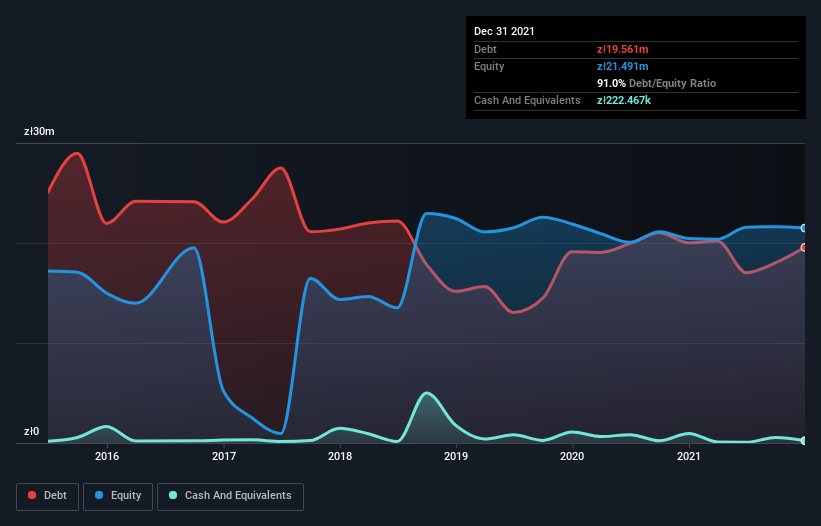
David Iben put it well when he said, 'Volatility is not a risk we care about. What we care about is avoiding the permanent loss of capital.' So it seems the smart money knows that debt - which is usually involved in bankruptcies - is a very important factor, when you assess how risky a company is. We can see that Miraculum S.A. (WSE:MIR) does use debt in its business. But the more important question is: how much risk is that debt creating?
What Risk Does Debt Bring?
Debt is a tool to help businesses grow, but if a business is incapable of paying off its lenders, then it exists at their mercy. If things get really bad, the lenders can take control of the business. While that is not too common, we often do see indebted companies permanently diluting shareholders because lenders force them to raise capital at a distressed price. By replacing dilution, though, debt can be an extremely good tool for businesses that need capital to invest in growth at high rates of return. When we think about a company's use of debt, we first look at cash and debt together.
Check out our latest analysis for Miraculum
What Is Miraculum's Debt?
The chart below, which you can click on for greater detail, shows that Miraculum had zł19.6m in debt in December 2021; about the same as the year before. And it doesn't have much cash, so its net debt is about the same.

A Look At Miraculum's Liabilities
We can see from the most recent balance sheet that Miraculum had liabilities of zł13.9m falling due within a year, and liabilities of zł21.7m due beyond that. Offsetting these obligations, it had cash of zł222.5k as well as receivables valued at zł4.87m due within 12 months. So its liabilities total zł30.5m more than the combination of its cash and short-term receivables.
This deficit is considerable relative to its market capitalization of zł43.7m, so it does suggest shareholders should keep an eye on Miraculum's use of debt. This suggests shareholders would be heavily diluted if the company needed to shore up its balance sheet in a hurry. There's no doubt that we learn most about debt from the balance sheet. But you can't view debt in total isolation; since Miraculum will need earnings to service that debt. So if you're keen to discover more about its earnings, it might be worth checking out this graph of its long term earnings trend.
In the last year Miraculum wasn't profitable at an EBIT level, but managed to grow its revenue by 38%, to zł34m. With any luck the company will be able to grow its way to profitability.
Caveat Emptor
While we can certainly appreciate Miraculum's revenue growth, its earnings before interest and tax (EBIT) loss is not ideal. Indeed, it lost zł2.8m at the EBIT level. Considering that alongside the liabilities mentioned above does not give us much confidence that company should be using so much debt. Quite frankly we think the balance sheet is far from match-fit, although it could be improved with time. However, it doesn't help that it burned through zł4.4m of cash over the last year. So in short it's a really risky stock. When analysing debt levels, the balance sheet is the obvious place to start. However, not all investment risk resides within the balance sheet - far from it. For example Miraculum has 4 warning signs (and 2 which shouldn't be ignored) we think you should know about.
At the end of the day, it's often better to focus on companies that are free from net debt. You can access our special list of such companies (all with a track record of profit growth). It's free.
New: Manage All Your Stock Portfolios in One Place
We've created the ultimate portfolio companion for stock investors, and it's free.
• Connect an unlimited number of Portfolios and see your total in one currency
• Be alerted to new Warning Signs or Risks via email or mobile
• Track the Fair Value of your stocks
Have feedback on this article? Concerned about the content? Get in touch with us directly. Alternatively, email editorial-team (at) simplywallst.com.
This article by Simply Wall St is general in nature. We provide commentary based on historical data and analyst forecasts only using an unbiased methodology and our articles are not intended to be financial advice. It does not constitute a recommendation to buy or sell any stock, and does not take account of your objectives, or your financial situation. We aim to bring you long-term focused analysis driven by fundamental data. Note that our analysis may not factor in the latest price-sensitive company announcements or qualitative material. Simply Wall St has no position in any stocks mentioned.
About WSE:MIR
Miraculum
A cosmetics company, develops and markets face and body care, perfume, depilation, and make-up products for men and women in Poland and internationally.
Adequate balance sheet and fair value.
Market Insights
Community Narratives



